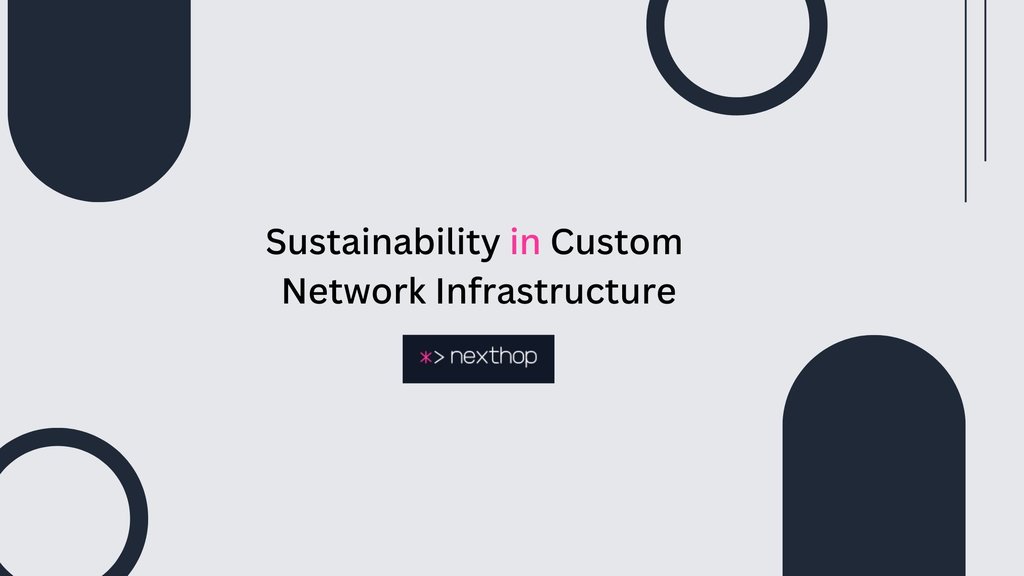
Sustainability in Custom Network Infrastructure
Today, sustainability plays a vital role in a corporate strategy-driven business due to the fast pace with which everything changes all around it. The business world is undergoing an intense upheaval in IT and networking in response to efforts toward lessening environmental footprints and meeting customer demands. The impetus for sustainable IT and network infrastructure has grown very significant over the years, stimulated by regulatory demands and concern about climate change, besides the clear wish to achieve effective operational efficiency.
Sustainability is an essential aspect in today's fast-moving world in business concerning corporate strategy. As companies strive to lessen their environmental footprints and at the same time meet customer demands, the IT and networking worlds have undergone a tremendous amount of change over the years. People will be expecting a very big demand to be satisfied in the near future concerning the area of sustainable IT and network infrastructures for many reasons like the regulatory needs, climate change concerns, and just the clear wish for effective operational efficiency.
What Is Custom Network Infrastructure?
The customized network infrastructure delivers tailored solutions for networking systems for maximum possible performance and efficiency improvements. Therefore, the organization can tailor its communication network for direct data transfer, moving an entire organization toward overall operational efficiency. Such systems are usually helping to perform ecologically friendly future by facilitating such sustainable behaviour.
The Need for Sustainability in Networking
- Environmental Impact: Energy consumption and carbon emissions are heavily influenced by the IT industry on a global scale. Organizations that follow the sustainable networking model will be vastly able to reduce their environmental footprint and act against climate change.
- Corporate Responsibility: Hence, organizations will have to commit themselves-all because the ardor presently drives towards their sustainable development expectations. Sustainable Networking will help an organization keep pace with emerging expectations and build its image.
- Economic Benefits: Investment in establishing sustainable network infrastructure would substantiate as one of the prime avenues to significant cost reductions in energy, hardware cooling, and operating efficiencies.
Key Principles of Sustainable Network Infrastructure
- Energy Efficiency: Investing in efficient technologies e.g. switches, routers, and servers, would, however, accrue extensive savings in terms of energy. Energy saving devices are said to have saved 40% electricity compared to their previous models. The operation of dynamic power management systems increases energy efficiency through device shutdown.
For example, 40% more electricity is saved by energy efficient devices than earlier models. Further, dynamic power management systems increase energy efficiency by shutting off devices when they are not in use.
- Energy Utilization Efficiency: Install energy certified equipment consumers such as office equipment.
- Intelligent energy management: Applying techniques such as power save mode and Dynamic Voltage Frequency Scaling.
- Energy-efficient data centers: Development of data centers with advanced cooling systems and optimal power distribution.
- Recyclable and Modular Hardware: The organization of components in modules allows businesses to pressure modulating or replacement functions within the system without straightening the whole process. It lengthens the life of network equipment while reducing the carbon footprint of electronic waste. Furthermore, it can use exchanged raw material in hardware manufacture to minimize environmental impact.
- Modular Design: Involves the application of modularized components that could easily be replaced or improved thus minimizing electronic waste.
- Recyclable Materials: Use hardware made of recyclable materials and make an end-of-life recycling program.
- Green Data Centers: Networking sustains one another by paving the way-find new connections and help make green data centers into energy-efficient design and cooling technology. Consolidating servers and optimizing resource consumption can significantly reduce the carbon footprint of companies.
- Renewable Energy: Utilize renewable energy sources such as solar and wind energy so that we are less dependent on fossil fuels.
- Water-efficient cooling: Make use of cooling technologies such as air-side economizers and adiabatic cooling.
- Cloud Integration: Cloud computing has allowed many users to share resources, thus requiring less energy consumption and hardware. With installation of applications in cloud environments, they are said to increase operational efficiency while reducing their environmental impact.
- Cloud services: Shifting workloads from on-premise to cloud providers who value sustainability and energy efficiency.
- Minimizing Hardware Footprint: Consolidate IT resources with a view of reducing the number of hardware items on-premises.
- Lifecycle Management: Sustainable networking refers to the entire lifecycle of networks from design and fabrication through deployment to disposal. Responsible recycling and reuse of components need to be incentivized among companies.
- Extended Hardware Life: Proactive maintenance and repair procedures aim to increase the longevity of the equipment.
- Data Destruction Nailing: data security and environmental compliance for hardware disposal.
Experience the Power of Nexthop`s Agile and Reliable Telecommunication Solutions
Contact Us Today and Future Proof Your Business Connectivity
The Role of Nexthop in Sustainable Networking
Nexthop is spearheading sustainable networking through tailor-made solutions for energy efficiency and resource optimisation. By deploying the newest technologies and best practice methodologies, Nexthop enables organisations to become greener while optimising their operational efficiency.
Nexthop designs and deploys bespoke sustainable network solutions for enterprises. It assists enterprises on that journey by emphasizing energy efficiency in the design and optimisation of resource use within their networks. The spectrum of services also includes energy-efficient hardware selection and the integration of renewable energy sources into network operations.
Nexthop's sustainability commitment has benefits that extend to the efficient operation of the business since they will not only be environmentally cautious but will also be able to save on costs. By applying the best practices in modern technology with sustainable networking, Nexthop is helping organisations to flourish in an increasingly environmentally concerned industry.
However, there is no longer a choice to integrate sustainability into the processes of a company. It is a requirement for the long-term survival of firms today. Investing in sustainable IT and network infrastructure presents a pathway to operational efficiency and corporate responsibility for businesses facing the challenge of climate change and resource shortages. Organizations that want to develop strong networks that answer both their business and environmental agendas should implement certain fundamental principles such as energy-efficient designs, modular designs, green data centers, cloud integration, lifecycle management.
Nexthop is among the pioneers in this way, offering experience in tailored sustainable network solutions that help businesses grow while imbuing positive impacts on the environment. With entering a period of transitioning towards the highly sustainable future, the companies practicing these values will find them helpful in raising them up and contributing to a better environment for future generations.
Are you ready to start your journey toward sustainability? Contact Nexthop today and learn how we can help you develop a greener, more efficient network.
FAQs
“What’s the ROI of investing in sustainable network infrastructure?”
Investment in an eco-sustainable and healthy network infrastructure is likely to yield spectacular returns in terms of reduced energy cost, operational savings, and improved brand perception. Companies that embrace sustainability seem to enjoy increased loyalty among consumers and are different from their competitor’s sources by commercial assessment.
“How can small businesses adopt sustainable networking?”
These minor interventions can help small enterprises develop their sustainable networking. As an example, they could put up energy-efficient equipment, use virtualization techniques, and use cloud services to optimize their resources. Further, they may look at partnering with suppliers such as Nexthop to get tailored solutions that fit their requirements and budget.
“Are there government incentives for green IT practices?”
Most of the governments offer these types of incentives: tax rebates, grants, or subsidies for deploying energy-efficient technologies or renewable energy sources to organizations implementing green IT practices. They should check their local regulations and programs induced by the environmental concern.

Co-founder | Managing Director
Nexthop products
We provide a simple, specialised product portfolio
| Product / Available Speeds | 500 Mbps | 1 Gbps | 2.5 Gbps | 10 Gbps | 100 Gbps | 400 Gbps |
|
Fibre Internet - Multi-Gig Internet |
|
|
|
|
|
|
|
Datacentre DIA |
|
|
|
|
|
|
|
Layer 2 Ethernet |
|
|
|
|
|
|
|
IP Transit |
|
|
|
|
|
|
|
Wavelength |
|
|
|
|||
|
Dark Fibre* |
|
|
|
|||
|
Next XC - DC dark fibre* |
|
|
|
* For dark fibre and Next XC the customer supplies the SFP to enable the 10, 100 & 400Gbps
